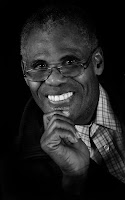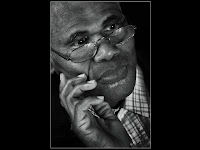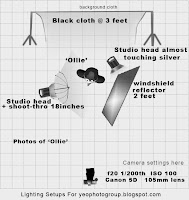I tried using unsharp mask but wasn't keen on the resulting halos and colour fringing often associated with normal everyday sharpening.
 I vaguely remembered reading an article on the web last year suggesting Lab Colour mode as an alternative method of sharpening - so I gave it a go.
I vaguely remembered reading an article on the web last year suggesting Lab Colour mode as an alternative method of sharpening - so I gave it a go.First thing is swap to Lab Colour mode, which is found under Image in the top toolbar.
Next, click on Channels in the Layers palette and select the Lightness layer. The other three layers will turn off when you do this. Find the normal everyday Unsharp Mask and whizz it up to 300% - don't worry it'll turn out just fine! (Obviously this 300% is not set in stone so just use that as a starting point, I have used as much as 500% with extremely good results.)
In the Radius box just beneath I went for 0.8 pixels and the bottom box, Threshold, was left at zero - click OK.
Click on the top layer to open up all the other channels again, then go back to Image and swap back into RGB mode. Select Layers as opposed to Channels and you're back in the world of good old layers which we all known and love.
 In case you haven't realised I'm a supporter of Jpegs - I have tried RAW but found it decidedly soft and absolutely everything needed working on wityh evry single image - time wasting! I'll continue to let the camera do the donkey work and I'm not tempted to bother trying RAW again, thank you very much. I take around 400 pictures a week, mostly experimenting with lighting and unusual effects and I want to see them right away, full screen.
In case you haven't realised I'm a supporter of Jpegs - I have tried RAW but found it decidedly soft and absolutely everything needed working on wityh evry single image - time wasting! I'll continue to let the camera do the donkey work and I'm not tempted to bother trying RAW again, thank you very much. I take around 400 pictures a week, mostly experimenting with lighting and unusual effects and I want to see them right away, full screen.Besides, I can still use all the Adobe Camera Raw tweaks on my Jpegs prior to opening them in Photoshop. However, if you want to prove me wrong - go on then, I challenge you to make a better picture via Raw in the camera!
After sharpening these photos were changed to black and white using a Black And White adjustment layer in CS3 and moving the red channel slightly to the right and the yellow channel a little bit further. This lightened up the shadow detail in Ollie's features without blowing the brightness of his shirt collar.
I guess one day I'll get used to how Actions operate and that'll speed things up enormously, but for now I enjoy using Photoshop so I'll plod along slowly. Even so, each of these images took less than ten minutes to start looking really good, then I started playing around with oval selections, inverting them, feathering to 130 pixels and finally using another adjustment layer, Levels this time, to introduce a little darkness around the outer edges.
I also use the same 130 pixel feather to make a selection and then press Control + M to bring up the Curves adjustment box and then drag the line down a bit to darken, make another selction and use Curves again to make that selection slightly lighter. This seems to work in a more pleasing manner than using the Dodge tool or the Burn tool.
 There were two lights used here, one via a shoot-thro brolly and the other bounced into a silver sunshield. Originally designed for a car windscreen on sunny days this £4 makeshift reflector is now supported on a couple lengths of plumbers piping. (See a previous post for info on how to make this easily assembled gadget.)
There were two lights used here, one via a shoot-thro brolly and the other bounced into a silver sunshield. Originally designed for a car windscreen on sunny days this £4 makeshift reflector is now supported on a couple lengths of plumbers piping. (See a previous post for info on how to make this easily assembled gadget.)Ialso used a black blanket background supported on plumbers waste pipe and a short length of plastic guttering fixed atop a single lighting stand. I designed that litle gadget over twenty years ago and still find it extremely quick and simple to erect.
The tip of the brolly was less than eighteen inches from Ollie's nose and to camera left, while the reflector was about two feet away to camera right with the flash only just out of camera view. These lights are ancient and rather warm in tone so I either use a DIY colour balance card, or carry out a custom white balance which is easy on the Canon camera, plus just a little tweak in Adobe Camera Raw before opening up into CS3.
 A setup like this uses very little space and most living rooms / lounges / or a large kitchen can be utilised. The studio flashes used here on Ollie are thirty years old and have no power controls, so my alternative set of Elichrom D-Lite 200watt would have been an absolute dream to use.
A setup like this uses very little space and most living rooms / lounges / or a large kitchen can be utilised. The studio flashes used here on Ollie are thirty years old and have no power controls, so my alternative set of Elichrom D-Lite 200watt would have been an absolute dream to use.I ought really to sell those old lights on EBay but hey, old habits die hard. Alternatively, I could have used a couple of old hotshoe flashes with equally good effect. What I'm trying to say is, use whatever lighting you have lying around and instead spend your money on a better lens, or some versatile software such as CS3, or maybe a more patient or attractive model.
Incidentally, I recently spent a couple of hours making up a whole arsenal of tiny diagrams to suit my own lighting needs. These are saved as a huge number of layers and kept as a PSD file, which enables me to move them around, rotate, turn off the ones not needed and flipping over those facing the wrong way. I love Photoshop!!!
